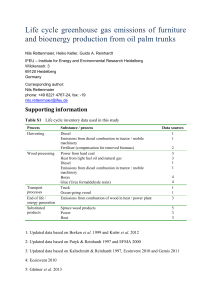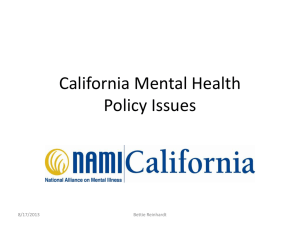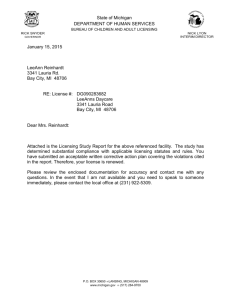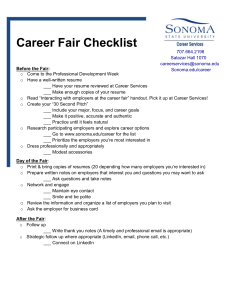The Predictable Managed Care Kvetch on the Rocky Road from
advertisement
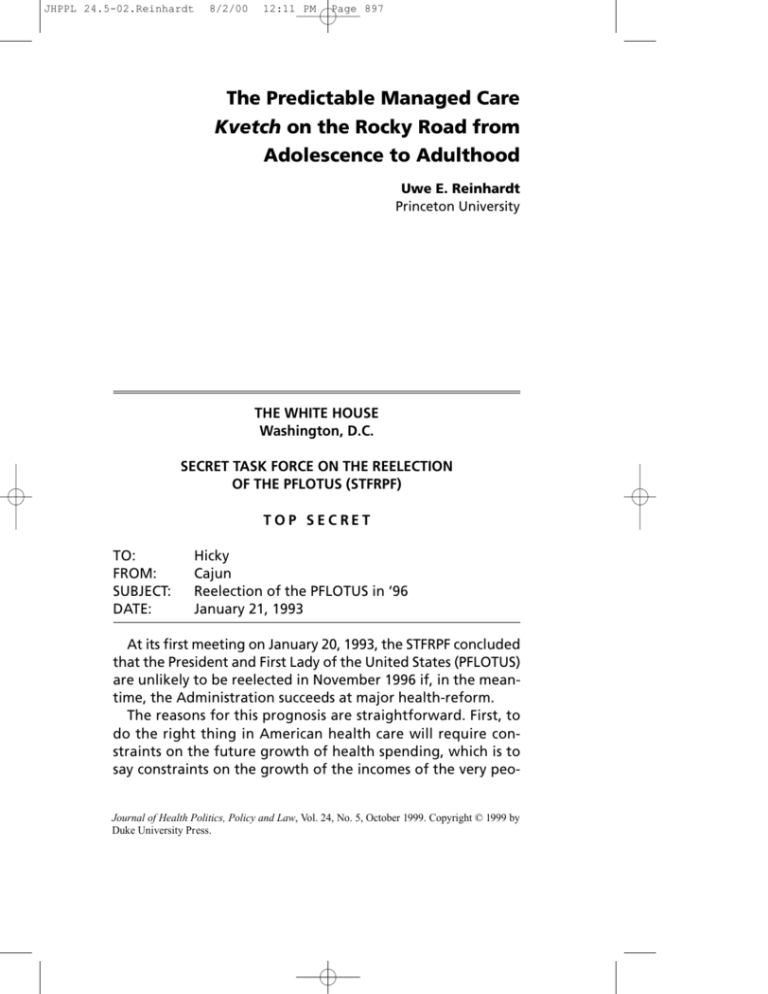
JHPPL 24.5-02.Reinhardt 8/2/00 12:11 PM Page 897 The Predictable Managed Care Kvetch on the Rocky Road from Adolescence to Adulthood Uwe E. Reinhardt Princeton University THE WHITE HOUSE Washington, D.C. SECRET TASK FORCE ON THE REELECTION OF THE PFLOTUS (STFRPF) T O P S E C RE T TO: FROM: SUBJECT: DATE: Hicky Cajun Reelection of the PFLOTUS in ’96 January 21, 1993 At its first meeting on January 20, 1993, the STFRPF concluded that the President and First Lady of the United States (PFLOTUS) are unlikely to be reelected in November 1996 if, in the meantime, the Administration succeeds at major health-reform. The reasons for this prognosis are straightforward. First, to do the right thing in American health care will require constraints on the future growth of health spending, which is to say constraints on the growth of the incomes of the very peo- Journal of Health Politics, Policy and Law, Vol. 24, No. 5, October 1999. Copyright © 1999 by Duke University Press. JHPPL 24.5-02.Reinhardt 898 8/2/00 12:11 PM Page 898 Journal of Health Politics, Policy and Law ple who own substantial parts of Capitol Hill and to whom we might want to look for general financial support as well. Second, an effective control of health care costs/incomes requires some unpopular measures that will offend the voting public. Among these measures is rationing of health care outright. Milliman & Robertson (a private actuarial firm in Seattle) has already developed tough guidelines for such rationing. Because these guidelines are likely to create a strong backlash among the general public (and among physicians who can stoke public resentment during every patient visit), this attempt at rationing health care had better not be linked to the White House. Health reform was promised during the election. Therefore, abandoning the effort now is not an option. To shield the PFLOTUS from the inevitable backlash to effective health care reform, however, the STFRPF recommends that this Administration submit to the Congress a health reform that will be dead on arrival on Capitol Hill (DOA) or, preferably, dead even before arrival (DEBA). Once the plan has failed, the task of controlling health spending will shift to the private sector, specifically to private employers and the managed care industry, whose leaders will then become the chief flak catchers for health reform. Not only will this strategy deflect the ire of the public away from the PFLOTUS, but also the White House can reap a political harvest by siding with the voting public against these flak catchers. The STFRPF agreed that Ira Magaziner, a long-time FOB/FOH, should lead the reform effort. First, as of this date Ira is still without the portfolio that he is owed. He has agreed to take on this thankless task as long as he gets a large office in the White House. Second, and more importantly, Ira has a solid track record in reengineering proposals that implode on their own complexity. (His most recent was an ill-fated proposal to restructure of the entire economy of Rhode Island.) Under Ira’s strategic stewardship, the White House reform plan would go through several iterations—he calls them “toll gates”—and be submitted at each turn to our friends at the Brookings Institution (BI) for an audit. The BI will convene panels of experts to assess the feasibility of the reform proposal at JHPPL 24.5-02.Reinhardt 8/2/00 12:11 PM Page 899 Reinhardt ■ Managed Care Kvetch 899 that stage. If these experts judge the plan feasible, Ira will modify it further through additional tollgate exercises, until eventually the BI experts declare the plan unworkable. The PFLOTUS will then submit it to the Congress, after our having leaked the most damaging sections to the press ahead of time. Among these sections will be one proposing stiff criminal penalties for violating the proposed reform law, a tactic bound to breed political opposition. The Republicans on the Hill will, of course, reject our reform proposal regardless of its content. We can count on them. To further guarantee success at this strategic failure, we should keep at least some Democrats openly hostile to our reform effort as well. The STFRPF has identified Congressman Pete Stark (Chair, House Ways and Means Subcommittee on Health) as an early strategic target for this effort, which will be undertaken by Ira personally. In the next few months, Ira will assemble a task force of, say, 1,000 or so people. To heighten media interest in our effort, we will designate the task force as “secret” and sit back to wait for the inevitable lawsuits from the right. Ira will use selected members of this “secret” task force to orchestrate strategic leaks to the press, designed to render our healthreform plan DOA, if not DEBA outright. The editorial board of the Wall Street Journal is a natural target for this strategy, as are the folks at the Washington Times and even some at the Washington Post—certainly Jack Glassman and possibly David Broder. Finally, it would be helpful to turn the influential Jackson Hole Group (JHG) against our reform effort early on. Probably the easiest approach would be simply to offend Alain Enthoven some way or other. Ira probably could pull that off in one conversation. In any event, sooner or later the JHG will unwittingly play along with our strategy, because the JHG seems to have been taken over by executives from the care delivery system (whose incomes would be constrained by successful health reform) and by executives from the health insurance industry (who expect to gain as well by seeing any White House reform plan fail). In their self-chosen role as the nation’s future private health care regulators, the insurance executives will become JHPPL 24.5-02.Reinhardt 900 8/2/00 12:11 PM Page 900 Journal of Health Politics, Policy and Law the flak catchers that we seek to create with the strategic failure proposed here. The document above was found on a subway in Washington, DC, and was a top-secret White House memorandum dropped accidentally, one supposes, by Harold Ickes on his way to a Beltway tribunal out to grill him. The memorandum was written on 21 January 1993, just one day after the Clintons had ascended to the White House. Although the authenticity of this memorandum has not been formally established, its tone and content make it look authentic. Because the memorandum bears so directly on the topic at hand, it is leaked here for the reader’s enlightenment. The rest, of course, is history. Ira Magaziner’s strategic failure was successful beyond the STFRPF’s wildest expectations. Even before the laser-jet ink had dried on his mind-boggling plan, it was positively DEBA. So, for a while, was the thought that government could ever do any good in health care at all. As predicted by the STFRPF, the private health insurance industry did take on the role of regulator for American health care and in that role it did trigger the predicted backlash, first among the providers of health care (as their fees tumbled), then among the general public (as their choice of provider became limited and health care, occasionally, was not paid for by the health plans) and, finally, in the media, once its members themselves began to taste the fruits of more effective cost control in American health care. Mercifully for the executives of the muchmaligned managed care industry, their spectacular compensation packages eased their pain. For their part, the PFLOTUS did get reelected in November 1996, as planned, and they did reap the political benefit of a predictable backlash against the managed care industry. Finally, and predictably, America’s legendary rugged individualists once again revealed the leitmotiv that guides their tender souls: When the going gets tough, the tough run to the government! And run they now do. All in all, then, the STFRPF had it right. The roaring 1990s in American health care, and the wondrous saga of managed care so far, have been nothing if not thoroughly predictable. And thoroughly amusing. JHPPL 24.5-02.Reinhardt 8/2/00 12:11 PM Page 901 Reinhardt ■ Managed Care Kvetch 901 The Genesis of “Managed Care” The saga of the managed care industry in the United States is easily understood by anyone who has goaded offspring from childhood through adolescence to mature adulthood. Even the best parents find that a rocky road and, sometimes, a thankless task. Avoidable insult is added to unavoidable duress when parents make clumsy mistakes. One can think of the managed care industry as the health care analogue of somewhat less than perfect parents trying to goad both the providers and the users of health care from the fairyland tale of the proverbial free lunch toward the mature realization that there really is no free lunch—not even in health care.1 Remarkably, the fairy tale of the free lunch in health care had not been told by government, the usual suspect for all things untoward in America. That myth was inculcated in Americans by a dubious alliance among private employers, union leaders, private health insurers, and the providers of health care, all of whom hoped to benefit from that myth, as signatories to a social contract infelicitously called “employerprovided” health insurance. Economists were convinced employees themselves paid through commensurate reductions in take-home pay (Krueger and Reinhardt 1994; CBC 1992). Under this employment-based health insurance system, and until about 1990, employed Americans were taught to believe that their employer could and should assume financial responsibility for the illnesses of employees and their dependents. That belief effectively elevated the employer to the role of the employee’s parent in all matters of health care, a role employers continue to play to this day. Most employers were only too happy to assume that role as a come-on in the labor market, presumably because they knew that fringe benefits were simply part of the total price paid labor and, within that total compensation, a substitute for take-home pay. Apparently the typical employee does not think of fringe benefits that way, for at least two reasons. First, the collectivist group health insurance policy for a firm actually does represent socialized health insurance in the sense that it redistributes the cost of ill health from sick employees to healthy employees. Second, although employers normally do deduct the average per-employee cost of group insurance from the total price of labor (the firm’s total debits for labor costs to the payroll-expense account), employers do not make that deduction explicit on the employee’s paycheck. There the employer deducts only what the 1. Of course, millions of chronically uninsured Americans have known this all along, as have the millions of elderly Americans who have only the traditional Medicare semicoverage for the cost of their health care. JHPPL 24.5-02.Reinhardt 902 8/2/00 12:11 PM Page 902 Journal of Health Politics, Policy and Law employee believes to be his or her explicit contribution to health insurance coverage (now usually less than 25 percent, but much less during the 1970s and 1980s). Both factors, the socialization of health care costs within the firm (generally viewed a desirable feature) and the mere implicit (rather than explicit) deduction from gross wages of what employees believe to be the employers’ share of health insurance premiums appear to have fostered among employees the belief that someone other than they — the company — paid for the great bulk of their families’ health care. Thus did so many Americans come to believe in the fairy tale that health care is a free lunch. Until the early 1990s the private insurance carriers who managed this contract for employers temporarily bore the financial risk for this openended arrangement only for about the first year, because they were able to increase the insurance premiums they charged employers for this contract almost at will. During the late 1980s, for example, the annual increases in premiums for group health insurance policies reached the high double digits — often in excess of 20 percent — and yet employers paid them. Thus effectively freed by employers from the task of assuming and managing risk themselves, the private insurance carriers felt little compulsion to control their own outlays for health care. Instead of using negotiated fee schedules to pay the providers of health care, they paid each individual doctor the “usual and customer” charges, with few if any question asked. They paid hospitals and other providers of health care likewise. Furthermore, they scrupulously respected the hallowed tenet favored by organized medicine that no outsider should ever intrude into the doctor-patient relationship to control the volume of health services. In effect, then, employers and the insurance industry jointly had given the providers of health care a first claim on the paychecks of employed Americans who, as noted, generally remained unaware of that claim. While the average total compensation of American employees rose during the 1980s, their average take-home pay languished. The health sector absorbed a large share of the difference. To the chagrin of public officials, this fiscally irresponsible arrangement in the private sector also set the standard that had to be matched by the public sector’s health insurance programs, thereby driving up the cost of these programs. Unwittingly perhaps, but inexorably, the unbridled generosity of American employers vis-à-vis their employees (using the employees’ own money, to be sure) helped price kindness out of the soul of American taxpayers. The ever- JHPPL 24.5-02.Reinhardt 8/2/00 12:11 PM Page 903 Reinhardt ■ Managed Care Kvetch 903 escalating cost of health care made Americans less and less willing to embrace the idea of universal health insurance coverage. Whatever one may think of this peculiar social contract, it offered employed Americans and their families the most open-ended health insurance and the most luxurious health care anywhere in the world, and it literally showered the providers of health care with money. With minimal overt sharing of the health insurance premiums paid by employers and very little cost sharing at the time health care was received, employees and their families enjoyed completely free choice of doctors, hospital, prescription drugs, and medical therapy at the time of illness. Because few if any questions were ever raised by either the private insurers or employers about the use of health care made by employees, it is not surprising that so many Americans sincerely came to believe that rationing of health care is un-American, something done only by the government-run health systems abroad. This uncontrolled system of health care financing strained the economy as early as the mid-1970s, when the annual growth of labor productivity began to decline from over 3 percent to below 2 percent. The system stumbled when double-digit increases in health insurance premiums coincided with the severe recession of the late 1980s and 1990s. As the employers’ health insurance premiums began to absorb ever-larger proportions of total labor compensation, industrial relations in the labor markets turned correspondingly sour. Eventually, the increasingly desperate American employers began to reevaluate the open-ended social contract they had written and supported for so long, and they looked around for an alternative deal. That deal was known as “managed care.” The central driver of this deal was a substantial reduction in the freedom of choice among the providers of health care that American employees and their families had long enjoyed. Instead of free choice at the time of illness, employees henceforth were forced to make a choice among competing private health plans that would then have a contractual right to regulate medical treatments the employees and their families received at the time of illness. The preferred term in the industry for this intrusion into the doctor-patient relationship is “managing care.” From the perspective of individual patients and their physicians, however, the more illuminating term is “private health-care regulators” (Berenson 1991). These private regulators differ from government regulators in several respects. Unlike government regulators, many of the private regulators are driven by the profit motive. Depending largely on their own ide- JHPPL 24.5-02.Reinhardt 904 8/2/00 12:11 PM Page 904 Journal of Health Politics, Policy and Law ology, individual consumers may view this as either a plus or a minus. But unlike government regulators, private health care regulators cannot ration health care through upstream limits on the overall capacity of the entire health system. Thus, they cannot prevent the delivery of care that they deem unwarranted or that they seek to subject to implicit rationing by physicians (a preferred approach to rationing in most other countries — e.g., in neighboring Canada or in the United Kingdom). The private regulators can, however, refuse to pay for such care. In their own eyes, a mere refusal to pay for care may not appear as the withholding of the care itself, or even of regulating the process of health care delivery. In the eyes of patients, health care providers, the media, and the courts, however, that refusal tends to be viewed as “rationing” and is now the source of much friction in American health care. As the American managed care industry is learning, rationing health care explicitly, with appeal solely to money budgets and within sight of excess physical capacity, is much more irritating than seems to be the implicit rationing with appeal to limited physical capacity that is commonly practiced abroad. The Successes of “Managed Care” Although the media produce anecdote after sensational anecdote pointing to a serious erosion of the quality of American health care under managed care, a detached and thorough recent review of the overall effect of managed care on the quality of American health care does not support widespread belief that the quality of health care has deteriorated. So far the scientific evidence is inconclusive (Miller and Luft 1997). The industry certainly can claim credit for spearheading the first systematic assault on the highly varied and inexplicable medical practice patterns of individual physicians and hospitals and of clinical outcomes they achieve. In the process, the industry has discovered a disturbing unevenness in the quality of American health care, a shortcoming that the medical profession had all but ignored in the “good old days” of complete physician autonomy and that even now has been slow to address by organized American medicine (Newcomer 1998). To quote Michael L. Millenson (1997b) author of the influential book Demanding Medical Excellence: Doctors and Accountability in the Information Age (Millensen 1997a), “I would be willing to bet that your average HMO executive, influenced by the same capitalist incentives the AMA [American Medical Association] used to praise, eliminates more inappropriate care in a month than the JHPPL 24.5-02.Reinhardt 8/2/00 12:11 PM Page 905 Reinhardt ■ Managed Care Kvetch 905 cooperative effort the AMA and its partners was able to do over several years.” The managed care industry also can take credit for having been instrumental in breaking, at long last, the intolerable upward spiral in American health spending that had been driven for decades by the old, “employer-provided” health insurance system. In the process, the managed care industry indirectly helped increase the take-home pay of employed Americans above the levels that these paychecks would have reached if the double-digit premium increases passively swallowed by employers in the late 1980s had persisted into the 1990s. Unfortunately, as already noted, for the most part employees do not seem to know that the “employer-paid” premiums for their health insurance actually do come out of their own paychecks. Therefore, American workers have remained unaware of the benefits bestowed on them by the managed care industry. On the other hand, they are acutely aware of the cost of managed care, namely, the loss of the completely unfettered access they hitherto had to a luxurious, open-ended health system, with few questions asked and no rationing at all. The Industry’s Shortcomings The backdrop of the decades-old, limitless, fairyland health care in which most Americans had been reared since World War II highlights the difficult task now faced by the managed care industry. Somehow it must gently guide Americans from the irrational exuberance of adolescence in health care toward the mature recognition that all desirable things must be traded off against one another (which implies that all desirable things must be rationed somehow) (Eddy 1996: esp. chap. 27). That thankless task would have made the managed care industry highly unpopular, even if that task had been attempted by the media savvy Mother Theresa. Alas, media savvy and saintliness are not characteristics for which the managed care industry is noted. For one, the industry might have found its task easier had it made a more concerted effort to convince the media (and through it the general public) that much of the medical care rendered in this country lacks a robust scientific basis, and that the overall quality of American health care could be vastly enhanced without added cost if physicians and other health practitioners could be held to well researched practice guidelines. A vast and growing scientific literature on inexplicable geographic vari- JHPPL 24.5-02.Reinhardt 906 8/2/00 12:11 PM Page 906 Journal of Health Politics, Policy and Law ations in the delivery of medical procedures and on glaring gaps in the quality of American health care could have been adduced to support such claims. Curiously, the industry so far has not engaged the public on this topic or, if it has, that effort has failed. The media and the public seem unaware that the golden age of medicine had a dark side, such as harm that unnecessary medical procedures (such as heart and other serious surgery) can visit on patients. Indeed, the industry may have helped deflect attention from this troublesome aspect of the old health system through its heavyhanded imposition of purely mechanical practice guidelines that abstracted unduly from deeply held consumer preferences. Specifically, the industry added genuine insult to unavoidable, and mainly imagined, injury by its fanatic obsession with reducing the average length of stay (ALOS) in hospitals as a means of cost control (Reinhardt 1996; TaiSeale, Rodwin, and Wedig 1999). Managed care companies typically pay hospitals a negotiated, flat per diem. Rather than letting the per diems vary roughly in line with the incremental (avoidable) costs of the particular days in a given hospital stay, the per diems are the same for every day in a stay. Thus mispriced, the convalescent days in a hospital stay appear much costlier to the insurance carrier than it is to the hospital and to society as a whole. The predictable result of this thoughtless pricing policy was the eviction of mothers from the hospital only one day after a normal delivery. As I have argued in my exploration of “How Much Jell-O Can a Mother Eat?,” this mindless policy not only lacks a sound economic rationale; as the industry has learned to its chagrin, it is also a public-relations blunder with serious political consequences for the industry (Reinhardt 1999). Finally, the public image of the managed care industry has suffered from a lack of the transparency called for in the theory of consumerdriven “managed competition” (Ellwood, Enthoven, and Etheredge 1992). As noted, that approach asks American families to select from a menu a private health care regulator who will then use the techniques of “managed care” to care for the health care of family members at the time of illness. It is a daunting proposition. At the least, it presupposes an information infrastructure that can help families to become well-informed choosers among revival regulators. The prospective enrollees in health plans ought to have credible information on the comportment of the competing plans. Ideally, they also need to have information on the quality of care rendered by the providers of health care who are associated with the rival health plans. JHPPL 24.5-02.Reinhardt 8/2/00 12:11 PM Page 907 Reinhardt ■ Managed Care Kvetch 907 The managed care industry can claim that it has tried to contribute to this information infrastructure through its participation in the National Committee on Quality Assurance (NCQA). That effort, however, has not sufficiently progressed to satisfy the public’s hunger for information. In fact, the information structured by the NCQA — such as it is — is not even routinely available to consumers at this time. Furthermore, in principle the NCQA should be the creature solely of those who pay for health care, and not of those whom it monitors. For example, information on the degree of consumer satisfaction should never have been allowed to be self-reported by the plans, on a voluntary basis, as they are now. Instead, employers should have formed and funded coalitions that survey enrolled consumers externally (Williams 1998). In my view, the NCQA has compromised somewhat its stated mission by allowing the managed care industry too powerful a role in the organization. In the long run that awkward arrangement is unlikely to enhance the public image of the managed care industry itself because it will surround the industry with an information infrastructure that is problematic on its face. Conclusion After decades of a completely irresponsible and, indeed, irrational management of their health system, Americans by the early 1990s finally had reached a major crossroads in health policy. Americans could have followed the example set by, say, Canada or Germany. In those two countries, government takes a strong hand in controlling directly or indirectly (1) the availability of physical health care resources, (2) the money transfers made to the owners of these resources, per unit of resource (e.g., the payment per physician or per CAT scan), and (3) the manner in which health care is financed. In the American context, this alternative would have been, in effect, “Medicare for all.” As I have argued at length elsewhere, the health systems abroad do use sundry “managed care” techniques to control their health spending (Reinhardt 1998). In fact, many of these techniques are now being reinvented by the American managed care industry. Conspicuously absent from these foreign managed care techniques, however, is the limitation of choice among providers at time of illness and the intrusion of external care managers into the ongoing doctor-patient relationship. For the most part, the managed care techniques of other countries work more indirectly, through statistical providers profiles and regulatory limits on physical capacity (e.g., limits on the number of imaging centers). Impo- JHPPL 24.5-02.Reinhardt 908 8/2/00 12:11 PM Page 908 Journal of Health Politics, Policy and Law sition of these regulatory limits on prices and physical capacity would be highly problematic in the United States. The second branch of the crossroads faced by the United States in the early 1990s was, of course, what we now call “managed care,” but which really should be “managed competition” among private health-insurance plans that use “managed care” techniques to control their spending on health care. As part of this approach, each health plan separately (1) bargains fiercely and secretly with the providers of health care over the prices of health services, (2) limits to some degree the enrollees’ freedom of choice among providers at time of illness, and (3) from time to time intrudes directly into the ongoing relationship between doctors and their patients to limit their freedom of choice among potential therapies. There are no system-wide government controls on prices and physical capacity under this approach, but each health plan can impose such limits on its own provider system and clientele. In 1994, with the angry slogan “Let government get off the people’s back!” America’s fabled “rugged individualists” voted for the second branch at the health care crossroad. The hope appears to have been that private markets would preserve for them forever the open-ended, fairyland health system to which well-insured Americans had become accustomed in the three post–WWII decades. At the time, the proponents of private markets openly reinforced that mistaken belief with the muchmouthed mantra that the allocation of health care resources through private markets would be an alternative to “rationing.” Every well-trained economist knows that to be a bold-faced lie because every good textbook in economics describes the price system as just one of many methods of rationing scarce resources among members of society. Ultimately, to be effective, the managed care industry must ration health care by refusing to pay for marginally beneficial medical procedures or products that are deemed (by the care managers in the private health plans) not to be worth their cost. Still with memory of their cherished fairyland health system, both patients and providers naturally bridle at that very idea, just like adolescents bridle at, for them, the novel idea that life is full of hard choices. And so, only half a decade after embracing the idea of “managed competition with managed care,” America’s “rugged individualists” are beginning to show their more tender side, as self-pitifully and pitiably they plead with the White House, with the Congress, with their state governments and with the courts to jump right back onto their backs, to protect them from the forces of private markets that, in their more rugged moments, they had professed to adore. After all they have done for the JHPPL 24.5-02.Reinhardt 8/2/00 12:11 PM Page 909 Reinhardt ■ Managed Care Kvetch 909 pocketbooks of these American health care “consumers,” the leaders of the managed care industry now find themselves stunned at this unseemly display of disaffection and ingratitude, as lobbyists hastily draw up battle plans to combat this unexpected backlash (which was, however, perfectly predictable). Not surprisingly, the politicians who lead by following now deploy their thought and energy to implement the following “New-Age Ethic for American Individualists,” which appeared in the New York Times, 18 November 1998: A New Improved Social Ethic for American Health Care If you happen to be well insured we, your political leader-followers, deem you very precious, as we lie awake at night worrying that you might be denied some medical procedure that your physician wishes to apply, that you therefore crave, but that your private health plan refuses to buy for you, because that plan judges it only marginally beneficial or even useless. Rest assured that we shall use the government’s coercive power to protect you from the vagaries of the free market. Of course, if you happen to be among the over 40 million or so uninsured Americans, then you’re off our moral radar screen altogether, even if you are a child. As our distinguished fellow citizen Monica Lewinsky so admirably put it in the lingo of our times, for you “It’s, like, whatever.” Ought one to have sympathy for managed care kvetching that rides on such a social ethic? Perhaps; but this author demurs. References Berenson, Robert A. 1991. A Physician’s View of Managed Care. Health Affairs 10(4):106 – 119. Congressional Budget Office (CBC). 1992. Economics Implications of Rising Health Care Costs, Washington, DC: U.S. Government Printing Office. Eddy, David M. 1996. Clinical Decision Making: From Theory to Practice. Boston: Jones and Bartlett. Ellwood, Paul M., Alain C. Enthoven, and Lynn Etheredge. 1992. The Jackson Hole Initiatives for a Twenty-First Century American Health Care System. Health Economics 1:149 – 168. Krueger, Alan B., and Uwe E. Reinhardt. 1994. The Economics of Employers versus Individual Markets. Health Affairs 13(2):34 – 53. JHPPL 24.5-02.Reinhardt 910 8/2/00 12:11 PM Page 910 Journal of Health Politics, Policy and Law Millensen, Michael L. 1997a. Medical Excellence: Doctors and Accountability in the Information Age. Chicago: University of Chicago Press. ———. 1997b. “Miracles and Wonder”: The AMA Embraces Quality Measurement. Health Affairs 16(3):183 – 194. Miller, Robert H., and Harold S. Luft. 1997. Managed Care Performance: Is Quality of Care Better or Worse? Health Affairs 16(5):7 – 27. Newcomer, Lee N. 1998. Perspective: Physician Heal Thyself. Health Affairs 17 (4):32 – 35. Reinhardt, Uwe E. 1996. Spending More through Cost Control: Our Obsessive Quest to Gut the Hospital. Health Affairs 15(2):145 – 154. ———. 1998. Accountable Health Care: Is It Compatible with Social Solidarity? London: Office of Health Economics. ———. 1999. Efficiency and Civility in Maternity Care, or “How Much Jello Can a Mother Eat?” Medical Care Research and Review 56(1):47 – 54. Tai-Seale, M., M. Rodwin, and G. Wedig, G. 1999. Drive-Through Delivery: Where Are the “Savings”? Medical Care Research and Review 56(1):30 – 46. Williams, Sarah. 1998. Growing Reliance on Self-Reported HEDIS Data Underscores Need for Auditing. Medicine and Health Perspectives. New York: Faulkner and Gray’s Health Care Information Center, 18 May.
